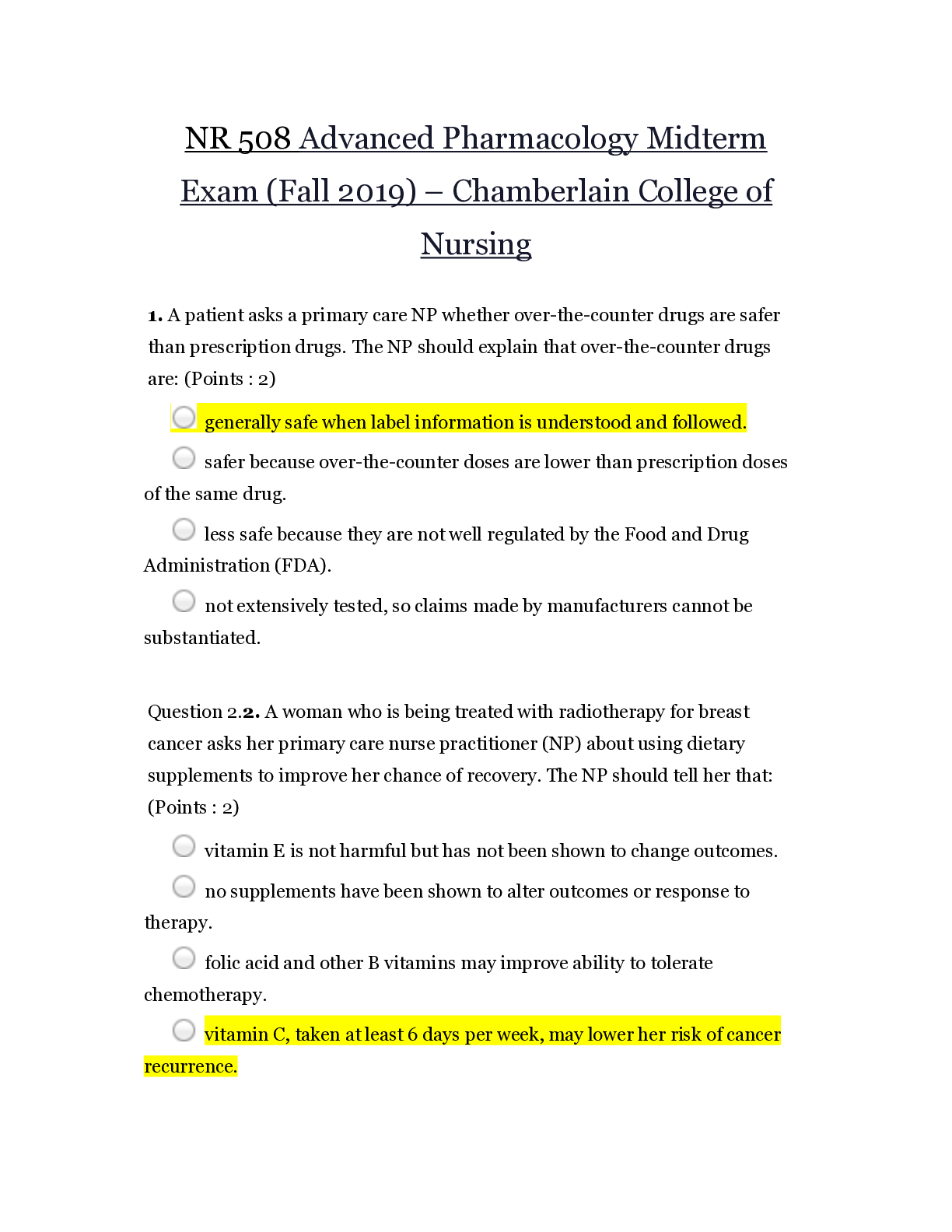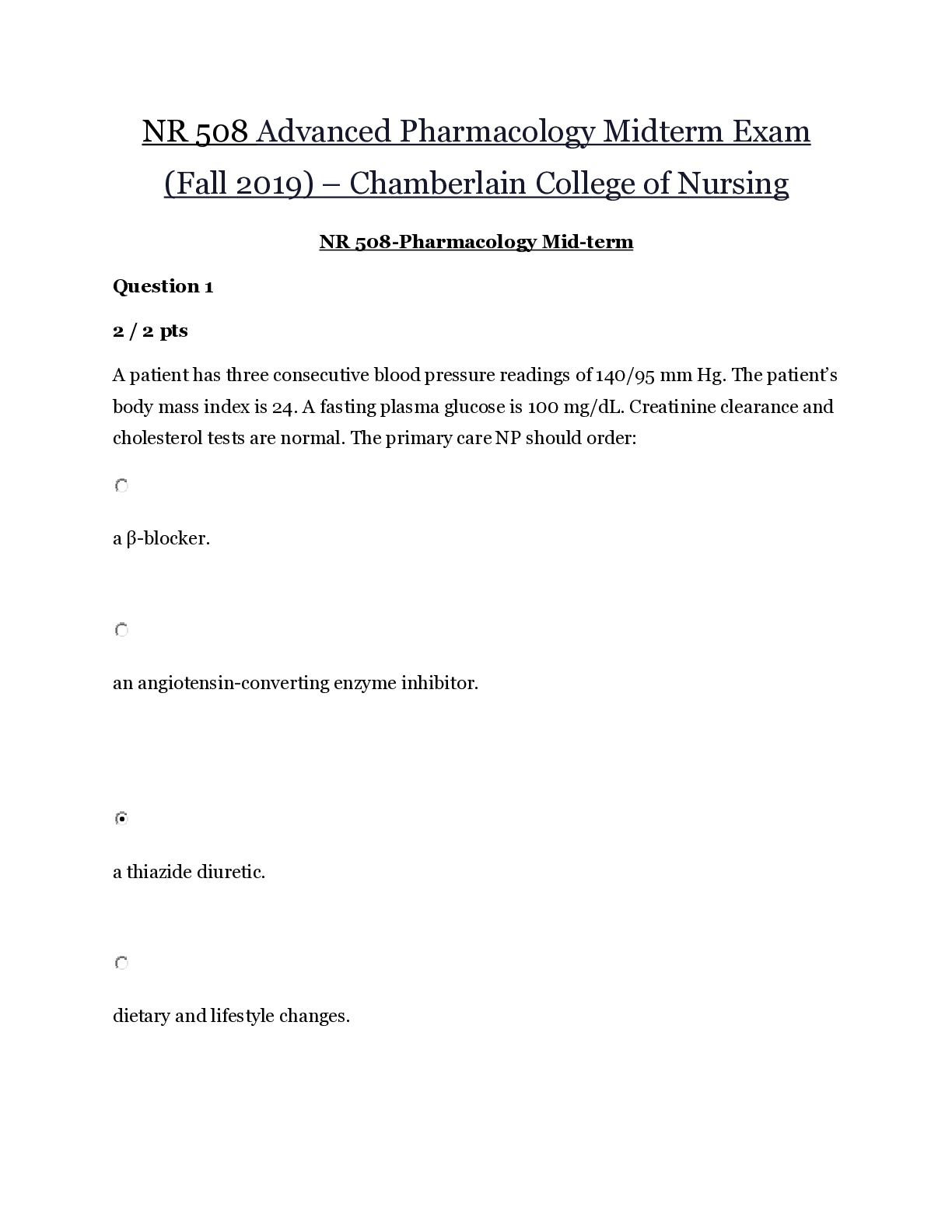*NURSING > EXAM > NR 509 IMMERSION exam 2018 – Chamberlain College of Nursing | NR 509 IMMERSION exam 2018 (All)
NR 509 IMMERSION exam 2018 – Chamberlain College of Nursing | NR 509 IMMERSION exam 2018
Document Content and Description Below
NR 509 IMMERSION exam 2018 – Chamberlain College of Nursing NR 509 Immersion Physical Examination Study Guide A head to toe (cephalo-caudal), and anteriorposterior approach should be used when con... ducting the exam. Students should verbalize each exam step and also identify cranial nerves by name and number. *Exam should be completed in 30 minutes or less. *No deductions given for exam steps out of order. Introduce yourself to the patient. Have patient sit up HEAD AND FACE Inspects facial skin – note abnormal lesions Inspect head for size, symmetry, midline position Palpates lymph nodes of the head and neck: preauricular, postauricular, occipital, tonsillar, submandibular, submental, anterior cervical, posterior cervical, supraclavicular (verbalize these) CN 5 (Trigeminal) Motor – palpate over the masseter muscle as patient clenches jaw Sensory – light touch sensation to forehead, cheeks, chin, nose (patient closes eyes and identifies where they are being touched) CN 7 (Facial) Inspect for facial symmetry with smile, frown, raise eyebrows, puff cheeks, pucker lips EAR Inspect outer ear for skin lesions and symmetry Inspect auditory canal and TM (using otoscope) Palpate pinnae and tragus for nodules and tenderness CN 8 (Acoustic) Whisper Test (whisper words out of patient’s sight, and patient repeats words back) Test one ear at a time. EYE Inspects sclera and conjunctiva CN 2 (Optic) Assess gross visual acuity and peripheral/central vision CN 2 (Optic) Check pupillary response to light [PERRL] CN 3, 4, 6 (Oculomotor, Trochlear, Abducens) Test for conjugate gaze with EOM NOSE Inspect nose midline and straight Assess nasal turbinates and septum (using light source) Palpates frontal and maxillary sinusesTHROAT AND MOUTH Inspect lips, teeth, gums, buccal mucosa, palate, tongue, the floor of the mouth (under the tongue), posterior pharynx, and tonsils (grade tonsils, if present) CN 9 and 10 (Glossopharyngeal, Vagus) Say “Ahh” and soft palate and uvula rise symmetrically with phonation (CN 10) * Gag reflex not tested for this exam (CN 9) CN 12 (Hypoglossal) Stick out tongue and move it left to right Palpate TMJ for any subluxation, tenderness, or crepitus NECK Inspect for obvious deformities and symmetry Palpates trachea – midline Palpates thyroid gland Palpates carotid artery pulsation Auscultate over the carotid for bruits Assess active ROM – flexion, extension, lateral flexion, rotation CN 11 (Spinal Accessory) Shrug shoulders against resistance HEART Auscultate in all 5 areas with the diaphragm and bell with the patient sitting (if stethoscope does not have a bell, then verbalize you would also auscultate with the bell) Verbalize Areas: Aortic Pulmonic Erb’s point Tricuspid Mitral ANTERIOR CHEST Inspect for obvious deformities and symmetry Auscultate lung sounds in anterior lung fields POSTERIOR CHEST (BACK) Auscultate posterior lung fields: Start above scapula alternating side-to-side in intercostal spaces. Go down into bases of lungs. Assess lateral lung fields (get right middle lobe) UPPER EXTREMITIES *All ROM & DTR examination only needs to be performed unilaterally for purposes of the immersion evaluation. Strength testing should be performed bilaterally. Inspect the joints of the hands – redness, swelling, deformities Palpate for capillary refill Assess radial pulses Assess hand grips (bilateral) – 5/5 strength Assess passive unilateral ROM of the elbows (flexion, extension) Assess strength of biceps, triceps (bilateral) – flex/extend elbow against resistance – 5/5 strength Assess passive unilateral ROM of the shoulders (flexion, extension, internal rotation, external rotation, abduction, adduction) Assess cerebellar coordination with rapid alternating movement: Serial finger opposition, hand flip-flop Assess unilateral DTRs: Biceps, patellar, achilles - - - - - - - - - - - - - - - - - - - - Now I'm going to assess ROM of the knee, flexion & extension. Next, I'm assessing knees strength. Flex your knees, please. I'm going to place my hands on top & ask my pt to push up towards them. Now push back. Strength is 5/5 & equal. I'm going to do the ROM of the ankle. Supporting the ankle, dorsiflexion, plantar flexion, & rotation. I’ll also assess ankle strength. Point your toes up dorsiflex with resistance. Now point your toes down plantar flexion with resistance. Strength is 5/5 & equal bilaterally. Now I’ll assess the dorsalis pedis pulses. They are 2+ & equal. Now I’ll have you stand up for the spine exam. I'm going to inspect & palpate along both sides of the spine for any expected curvatures, alignment & tenderness. I'm going to do ROM of the spine. I'm going to ask you to bend over & touch your toes. Now straighten back up & extend backwards. Straighten back up & do a lateral flexion to one side & then the other. Now rotation to the R & to the L. There is good, active ROM. Next, I’ll assess for the Romberg & I'll have you just stand with your arms down by your side. Close your eyes for about 20 sec’s, I'm looking for any swaying. There is none & I would note a negative Romberg. Now I’ll assess your gait & ask you to take a few steps forward. Turn around & a few steps more. There is a steady & even gait. This concludes my physical exam. [Show More]
Last updated: 2 years ago
Preview 1 out of 8 pages

Buy this document to get the full access instantly
Instant Download Access after purchase
Buy NowInstant download
We Accept:

Reviews( 0 )
$12.50
Can't find what you want? Try our AI powered Search
Document information
Connected school, study & course
About the document
Uploaded On
Aug 09, 2020
Number of pages
8
Written in
Additional information
This document has been written for:
Uploaded
Aug 09, 2020
Downloads
0
Views
96








 – University of the People.png)

















